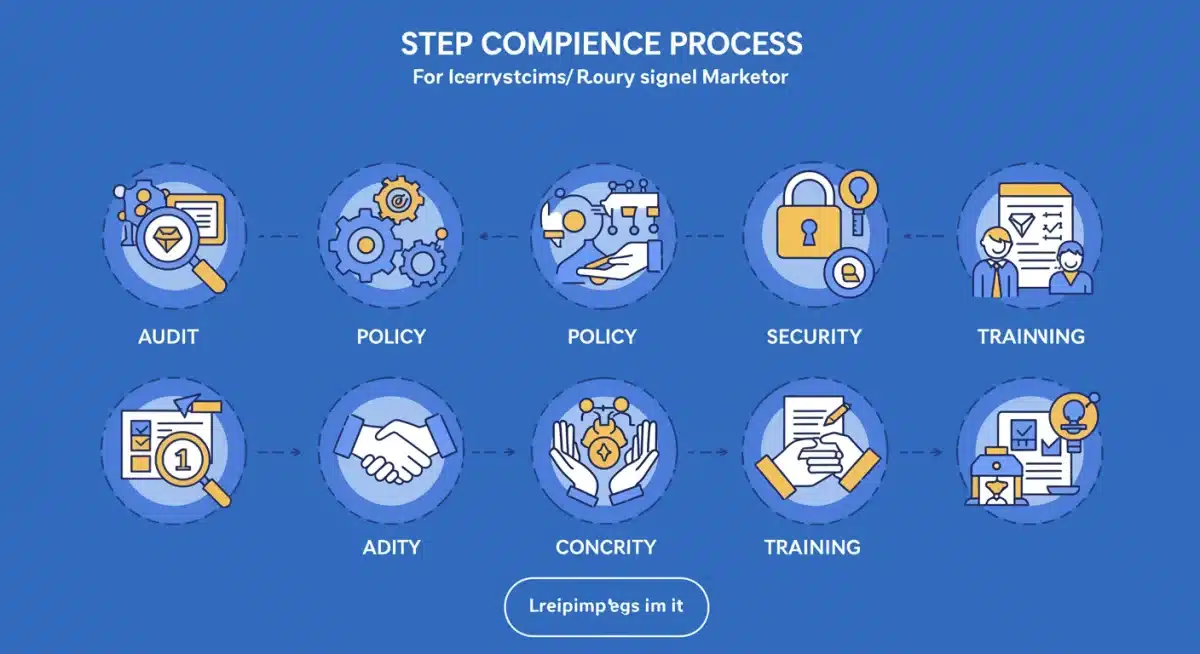US Privacy Regulations: 5-Step Compliance for Marketers

The landscape of US privacy regulations is constantly shifting, presenting significant challenges and opportunities for digital marketers. As of early 2024, new state-level laws are expanding consumer data rights, demanding immediate attention from businesses operating nationwide.
Understanding the Evolving US Privacy Landscape
The United States continues to operate without a single, comprehensive federal data privacy law, unlike the European Union’s GDPR. This fragmented approach means digital marketers must navigate a complex web of state-specific regulations, which are becoming increasingly stringent. Recent legislative activities across states like California, Virginia, Colorado, Utah, and Connecticut, alongside new entries such as the American Data Privacy and Protection Act (ADPPA) discussions at the federal level, underscore the urgent need for a robust compliance strategy.
These evolving laws primarily focus on granting consumers greater control over their personal data, including rights to access, correct, delete, and opt out of the sale or sharing of their information. For digital marketers, this translates into significant operational adjustments, from data collection practices to consent management and targeted advertising.
Key State-Level Developments
Several states have enacted or are implementing their own versions of data privacy laws, creating a patchwork of requirements. Understanding the nuances of each is critical for national and even regional marketing efforts.
- California Consumer Privacy Act (CCPA) / California Privacy Rights Act (CPRA): The pioneering law, now enhanced by CPRA, provides robust consumer rights and establishes the California Privacy Protection Agency (CPPA) for enforcement.
- Virginia Consumer Data Protection Act (VCDPA): Offers consumers rights similar to CCPA but with different thresholds for applicability and enforcement mechanisms.
- Colorado Privacy Act (CPA): Grants consumers comprehensive rights over personal data and imposes specific obligations on data controllers.
Further states are expected to join this trend, making ongoing monitoring of legislative developments essential for any digital marketer. The implications extend beyond just legal compliance; they touch upon brand trust and consumer relationships.
Step 1: Conduct a Comprehensive Data Audit
Before any compliance measures can be effectively implemented, digital marketers must first understand what data they collect, where it is stored, and how it is used. A thorough data audit serves as the foundational step in navigating US privacy regulations.
This audit involves mapping all personal data flows within an organization, identifying data sources, storage locations, processing activities, and third-party data sharing. Without a clear picture of your data ecosystem, it’s impossible to assess compliance gaps or implement necessary controls.
Identifying and Categorizing Data
The initial phase of the audit requires a detailed inventory of all data types. This goes beyond just names and email addresses to include IP addresses, device identifiers, browsing history, and any other information that could directly or indirectly identify an individual.
- Personal Identifiable Information (PII): Directly identifies an individual (e.g., name, address, Social Security number).
- Sensitive Personal Information (SPI): Requires heightened protection (e.g., health data, financial information, racial or ethnic origin).
- Pseudonymized Data: Data that has been processed so that it can no longer be attributed to a specific individual without the use of additional information.
Categorizing data helps in applying appropriate protection measures and understanding which specific privacy regulations apply to each data type. This granular approach ensures that no data point is overlooked.
Once data is identified, its lifecycle needs to be documented. This includes how it’s collected (e.g., website forms, cookies, third-party sources), how it’s stored (e.g., CRM systems, cloud servers), how it’s processed (e.g., for analytics, personalization, advertising), and how long it’s retained. Understanding the entire journey of data within your organization is paramount for effective compliance.
Step 2: Update Privacy Policies and Consent Mechanisms
With a clear understanding of your data practices, the next crucial step is to revise and update your privacy policies and consent mechanisms to align with current US privacy regulations. Transparency and clear communication with consumers are cornerstones of these laws.
Your privacy policy must accurately reflect your data collection, usage, and sharing practices in an easy-to-understand language. Generic templates are often insufficient; policies need to be tailored to your specific operational context and the jurisdictions you serve. Furthermore, consent mechanisms must be explicit, informed, and easily revocable.
Crafting Compliant Privacy Policies
A compliant privacy policy should be comprehensive yet concise, avoiding legal jargon where possible. It needs to address specific rights granted by laws like CCPA/CPRA, VCDPA, and CPA, such as the right to know, delete, and opt-out.
- Data Categories: Clearly list the categories of personal information collected.
- Purpose of Collection: Explain why each category of data is collected and how it will be used.
- Third-Party Sharing: Disclose any third parties with whom data is shared and for what purpose.
- Consumer Rights: Detail consumers’ rights regarding their data and how they can exercise them.
- Contact Information: Provide clear contact details for privacy-related inquiries.
Beyond the policy itself, the active management of consent is equally important. Marketers must implement robust systems for obtaining, recording, and managing consumer consent for various data processing activities. This includes cookie consent banners that allow granular control, explicit opt-in for marketing communications, and easy-to-find mechanisms for opting out of data sales or targeted advertising.
Step 3: Implement Robust Data Security Measures
Data privacy and data security are inextricably linked. While privacy regulations dictate how data should be handled and shared, security measures protect that data from unauthorized access, breaches, and misuse. Implementing robust data security protocols is a non-negotiable step in complying with US privacy regulations.
Even the most meticulously crafted privacy policy is meaningless if the underlying data is vulnerable. Marketers must work closely with IT and security teams to ensure that all personal data is adequately protected throughout its lifecycle, from collection to deletion.
Essential Security Practices
Several key security practices form the backbone of a strong data protection strategy. These practices are not static; they require continuous review and adaptation to emerging threats.
- Encryption: Encrypt data both in transit and at rest to prevent unauthorized access.
- Access Controls: Implement strict access controls, ensuring only authorized personnel can access sensitive data.
- Regular Audits & Assessments: Conduct periodic security audits and vulnerability assessments to identify and address weaknesses.
- Incident Response Plan: Develop and regularly test an incident response plan to effectively manage and mitigate data breaches.
Beyond technical measures, employee training on data security best practices is vital. Human error remains a significant factor in data breaches. Regular training helps foster a culture of security awareness, ensuring that all team members understand their role in protecting personal information. This proactive approach not only helps in compliance but also builds trust with consumers.

Step 4: Establish Data Subject Request (DSR) Procedures
A core component of modern US privacy regulations is the empowerment of individuals to exercise control over their personal data. This means businesses must have clear, efficient, and reliable procedures in place to handle Data Subject Requests (DSRs), such as requests to access, correct, delete, or opt out of the sale of personal information.
Failing to respond promptly and accurately to DSRs can lead to significant penalties and damage to brand reputation. Digital marketers must integrate these procedures into their operational workflows, ensuring that requests can be fulfilled within the legally mandated timeframes.
Streamlining DSR Fulfillment
The process for handling DSRs should be clearly communicated in your privacy policy and easily accessible to consumers. This typically involves a dedicated web form, email address, or toll-free number.
- Verification Process: Implement a robust process to verify the identity of the requester to prevent fraudulent requests.
- Internal Routing: Establish clear internal protocols for routing DSRs to the appropriate teams (e.g., legal, IT, marketing).
- Tracking & Documentation: Maintain detailed records of all DSRs received, actions taken, and communications with the data subject.
- Timely Response: Ensure responses are provided within the legally stipulated timeframe, typically 30 or 45 days, with options for extension under specific circumstances.
Automation tools can significantly aid in managing the volume and complexity of DSRs, particularly for larger organizations. These tools can help track requests, automate response generation, and ensure compliance with various regulatory deadlines. The goal is to make the DSR process as seamless as possible for both the consumer and the organization, fostering trust and demonstrating a commitment to data privacy.
Step 5: Implement Ongoing Training and Monitoring
Compliance with US privacy regulations is not a one-time project but an ongoing commitment. The final, yet continuous, step for digital marketers is to implement regular training programs for all employees and establish systematic monitoring processes to ensure sustained adherence to privacy policies and legal requirements.
The regulatory environment is dynamic, with new laws and amendments frequently emerging. Without continuous education and vigilance, even the most compliant organization can quickly fall behind. This step solidifies a culture of privacy within the organization.
Cultivating a Privacy-Aware Culture
Regular training sessions are essential for all employees who handle personal data, not just those in legal or IT departments. This includes marketing teams, sales, customer service, and product development.
- Initial Training: Provide comprehensive training upon hiring, covering all relevant privacy policies and regulations.
- Refresher Courses: Conduct annual or bi-annual refresher training to keep employees updated on changes in laws and internal policies.
- Role-Specific Training: Tailor training content to specific job functions, highlighting how privacy regulations impact their daily tasks.
- Best Practices: Educate on best practices for data handling, recognizing phishing attempts, and reporting security incidents.
Beyond training, continuous monitoring of compliance efforts is critical. This involves regular internal audits of data practices, reviewing consent mechanisms, assessing third-party vendor compliance, and staying informed about new legislative developments. Designating a privacy officer or a dedicated team can centralize these efforts, ensuring accountability and consistent application of privacy principles across the organization. This proactive approach minimizes risks and reinforces consumer trust in your data handling practices.
| Key Compliance Step | Brief Description |
|---|---|
| Data Audit | Identify, map, and categorize all personal data collected, stored, and processed. |
| Policy & Consent Updates | Revise privacy policies and consent mechanisms for transparency and explicit user choice. |
| Security Measures | Implement robust data security to protect against breaches and unauthorized access. |
| Ongoing Training | Ensure continuous employee education and monitoring of compliance efforts. |
Frequently Asked Questions About US Privacy Regulations
The primary regulations include state-specific laws like the California Consumer Privacy Act (CCPA) and California Privacy Rights Act (CPRA), Virginia Consumer Data Protection Act (VCDPA), and Colorado Privacy Act (CPA). These laws grant consumers significant rights over their personal data, impacting how marketers collect, use, and share information across the US.
An effective data audit involves identifying all personal data collected, mapping its flow from collection to deletion, categorizing data types (PII, SPI), and documenting storage locations and processing activities. This comprehensive inventory helps pinpoint compliance gaps and ensures all data handling practices are accounted for and aligned with privacy laws.
Explicit consent is crucial as many US privacy regulations require clear, affirmative agreement from consumers before collecting, processing, or sharing their personal data. This means pre-checked boxes are often insufficient. Marketers must provide granular control over data usage, especially for targeted advertising and data sales, to remain compliant and build consumer trust.
DSR procedures are the mechanisms through which individuals can exercise their rights, such as requesting access, correction, or deletion of their personal data. They are vital because privacy laws mandate that businesses respond to these requests within specific timeframes. Efficient DSR handling demonstrates compliance and fosters consumer confidence.
Staying updated requires continuous monitoring of legislative developments at both federal and state levels. Subscribing to legal and industry newsletters, engaging with privacy compliance experts, and participating in relevant forums are effective strategies. Regular internal training and policy reviews also ensure the marketing team remains informed and adapts to new requirements promptly.
What Happens Next
The current trajectory suggests an increasing number of states will enact their own privacy legislation, potentially leading to further fragmentation before any comprehensive federal solution emerges. Digital marketers must anticipate this ongoing evolution, maintaining agile compliance frameworks that can quickly adapt. The emphasis will remain on consumer control and data transparency, driving innovations in consent management and privacy-enhancing technologies. Organizations that prioritize proactive compliance and integrate privacy by design into their strategies will be best positioned for success in this complex regulatory environment.





